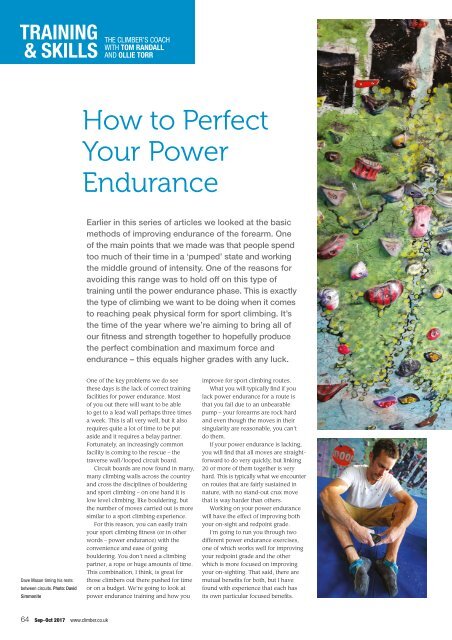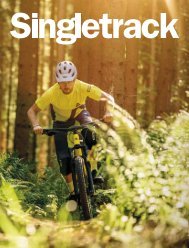Create successful ePaper yourself
Turn your PDF publications into a flip-book with our unique Google optimized e-Paper software.
training<br />
& skills<br />
the climber’s coach<br />
with Tom Randall<br />
and Ollie Torr<br />
How to Perfect<br />
Your Power<br />
Endurance<br />
Earlier in this series of articles we looked at the basic<br />
methods of improving endurance of the forearm. One<br />
of the main points that we made was that people spend<br />
too much of their time in a ‘pumped’ state and working<br />
the middle ground of intensity. One of the reasons for<br />
avoiding this range was to hold off on this type of<br />
training until the power endurance phase. This is exactly<br />
the type of climbing we want to be doing when it comes<br />
to reaching peak physical form for sport climbing. It’s<br />
the time of the year where we’re aiming to bring all of<br />
our fitness and strength together to hopefully produce<br />
the perfect combination and maximum force and<br />
endurance – this equals higher grades with any luck.<br />
Dave Mason timing his rests<br />
between circuits. Photo: David<br />
Simmonite<br />
One of the key problems we do see<br />
these days is the lack of correct training<br />
facilities for power endurance. Most<br />
of you out there will want to be able<br />
to get to a lead wall perhaps three times<br />
a week. This is all very well, but it also<br />
requires quite a lot of time to be put<br />
aside and it requires a belay partner.<br />
Fortunately, an increasingly common<br />
facility is coming to the rescue – the<br />
traverse wall/looped circuit board.<br />
Circuit boards are now found in many,<br />
many climbing walls across the country<br />
and cross the disciplines of bouldering<br />
and sport climbing – on one hand it is<br />
low level climbing, like bouldering, but<br />
the number of moves carried out is more<br />
similar to a sport climbing experience.<br />
For this reason, you can easily train<br />
your sport climbing fitness (or in other<br />
words – power endurance) with the<br />
convenience and ease of going<br />
bouldering. You don’t need a climbing<br />
partner, a rope or huge amounts of time.<br />
This combination, I think, is great for<br />
those climbers out there pushed for time<br />
or on a budget. We’re going to look at<br />
power endurance training and how you<br />
improve for sport climbing routes.<br />
What you will typically find if you<br />
lack power endurance for a route is<br />
that you fail due to an unbearable<br />
pump – your forearms are rock hard<br />
and even though the moves in their<br />
singularity are reasonable, you can’t<br />
do them.<br />
If your power endurance is lacking,<br />
you will find that all moves are straightforward<br />
to do very quickly, but linking<br />
20 or more of them together is very<br />
hard. This is typically what we encounter<br />
on routes that are fairly sustained in<br />
nature, with no stand-out crux move<br />
that is way harder than others.<br />
Working on your power endurance<br />
will have the effect of improving both<br />
your on-sight and redpoint grade.<br />
I’m going to run you through two<br />
different power endurance exercises,<br />
one of which works well for improving<br />
your redpoint grade and the other<br />
which is more focused on improving<br />
your on-sighting. That said, there are<br />
mutual benefits for both, but I have<br />
found with experience that each has<br />
its own particular focused benefits.<br />
64 Sep–Oct <strong>2017</strong> www.climber.co.uk






